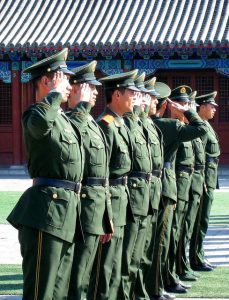Hope for Traumatic Brain Injury Recovery

Research is giving hope to recovery from traumatic brain injury. It started with a phone call from one military buddy to another. (Flickr / Creative Commons / Travis Wise)
This story starts with a phone call made from one army buddy to another. Chris Moroski was injured by a blast that blew up his vehicle and put him in the hospital with a traumatic brain injury. He called his friend Kit Parker to reconnect. They lost touch as one had been deployed to Iraq, the other to Afghanistan. After the first call, everything seemed fine. He just called to say hi, right? Then, after the third phone call, Parker knew something was wrong. Moroski couldn’t remember where he got his purple heart. This is something a soldier wouldn’t forget.
The full story was published in NPR. It was a long form journalistic piece written by Jon Hamilton. It is a very good example of NPR’s science reporting, which treated the subject of brain injury in combat very effectively. The story used an individual scientist’s story to apply to the large group of men and women that experience head injuries, not even limited to military veterans, but including everyone with a traumatic brain injury.
Parker was a member of the faculty at Harvard Medical School where he studied heart cells. When he got the phone call from his friend, he decided to change the trajectory of his career and commit to helping soldiers with traumatic brain injury. He also made a discovery that had the potential to change brain injury treatment for the better.
“What I knew about brain injury was zero,” Parker told NPR. Parker’s doctoral thesis looked at something called cardiac concussion. This is where a healthy athlete is struck by a ball or puck right above the chest and has a potentially fatal heart attack. His research led him to a protein called integrins. When struck, the integrins send unhealthy signals to the heart cells. This can be fatal. Parker wondered if the same was true for the brain. The story of a scientist on a quest to help brain injury unfolds.
It was 2011 when Parker’s lab published a paper saying that blasts could cause integrins to send signals that would disrupt connections among brain cells. Parker thought that drug companies would get on board. They could develop a drug that would block the signals or disrupt the cascade of events. However, no one wanted to join the effort. Drug companies had lost billions of dollars on treatments for Alzheimer’s. They were reluctant to join Parker’s fight.
Success for Parker meant more than helping only veterans. “Success is that a quarterback doesn’t suffer from dementia after being sacked,” Parker told NPR. “Success is that brain injury is no longer the leading cause of death of children. Success is a war fighter gets blown up in some Third World rathole somewhere and he can still count his change at Burger King afterwards.”
In 2015, there were 22,594 servicemen diagnosed with traumatic brain injury worldwide, according to the Defense and Veterans Brain Injury Center. This number may even be low, because if there is no visible injury, the injury is often ignored. Parker’s research has the potential to not only help servicemen but also people who get in car accidents or play football.
Parker’s lab is working on finding a protein that could be targeted by drug companies, requiring looking through thousands of options. Their grant money is running out, but they say there is no chance they will give up. Read the full length NPR story here.
We applaud this progress and are not surprised that it is coming outside of traditional neurology research. However, we must caution that this search for the elusive pill for brain injury is illusory. Brain injury involves many elements and no one thing is responsible for all the damage involved, nor can prevent the cascade of events. One of the reasons the drug companies have not embraced this research more fully is they are frustrated that it is so difficult for brain injury experts to agree on what a brain injury is. They want to invent the magic pill so they can parcel it out for billions of dollars. Hard to do that when no one can agree on what a brain injury is.